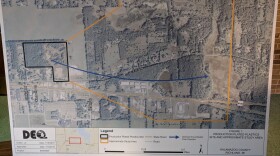It could be weeks before the water in Parchment, Michigan, is safe to drink, after industrial chemicals known as PFAS were found in its water supply at 20 times the recommended safe level. The recommended maximum safe level of PFAS in drinking water is 70 parts per trillion (ppt). Parchment’s water tested at 1,410 ppt.
Authorities have asked residents of Parchment, and some residents of Cooper Township, not to drink tap water, cook with it, prepare baby formula, or rinse fruits and vegetables. They say it is still safe to bathe, wash dishes, and do laundry with the water. Pets and farm animals also should not drink the water.
They're flushing the system with Kalamazoo water, which is known to be safe, and handing out free bottled water at Parchment High School. Kalamazoo City Utilities Director Jim Baker says the process of flushing the contaminated water out of Parchment’s system and then retesting and restoring safe drinking water could take weeks.
Baker says some contaminated water was discharged into the storm and sanitary sewer systems during the process of connecting Kalamazoo’s water supply with Parchment’s system.
“There was a limited amount of flushing that occurred last night initially to get the two systems connected together . ..into the storm and sanitary sewers. The amount of discharge that went into the sanitary sewers is being treated at the wastewater treatment plant,” says Baker.
Kory Groetsch is the Director of Environmental Health with the Michigan Department of Health and Human Services. He says the source of the contamination is not yet known.
“Right now it's going to be based on getting additional data to understand the source, so the department of environmental quality is going to go out and try to find where did this come from?” says Groetsch.
Some possible sources of PFAS contamination could be fabric manufacturing or metal plating sites, according to Incident Management Specialist at Michigan Department of Environmental Quality Mark DuCharme. PFAS chemicals are present in Scotchgard, which is used to protect fabric from stains, as well as products used to control mist in metal plating. Fire retardant foam containing PFAS has also long been used in large quantities at military bases.
According to Groetsch, the level of 70 ppt recommended as a safe maximum level in drinking water is between 30 and 300 times higher than the lowest level that caused health effects in animal tests. “Yes, the 1,410 is very concerning, and it’s going to take time to understand what that means, but it is also still within a range where ... no one is saying anyone would absolutely be harmed by this.”
The PFAS contamination was discovered as part of a testing program by the Michigan PFAS Action Response Team (MPART), a multi-agency program created to address the problem of PFAS contamination in drinking water. Governor Snyder has instructed MPART to work with the MDEQ, the Michigan Department of Health and Human Services, and the State Police to assist with the response to the water crisis in Parchment.
Separately, authorities are notifying two other communities of potential PFAS contamination.
The MDEQ alerted residents of Blair Township in Northern Michigan that the four-acre site previously occupied by Carl’s Retreading is contaminated with PFAS. Carl’s Retreading was a scrap tire recycling operation, and the location of a large tire fire in 1995 that lasted several weeks. Aqueous film-forming foam (AFFF), which contains PFAS, was used in an attempt to put the fire out. Sampling of drinking water at the nearby Blair Elementary School and a residence was completed on July 16. Those results are expected soon, and may require a coordinated response similar to Parchment.
Another potentially contaminated area, near Battle Creek, will be tested for drinking water contamination. For residents in the Helmer and Dickman Road area, surrounding the W.K. Kellogg Airport, the Michigan Department of Environmental Quality is hosting a public meeting Monday, July 30, to discuss results of initial testing, which it describes as mostly below the EPA health advisory level of 70 ppt. However, it says more tests are needed over an expanded area.






